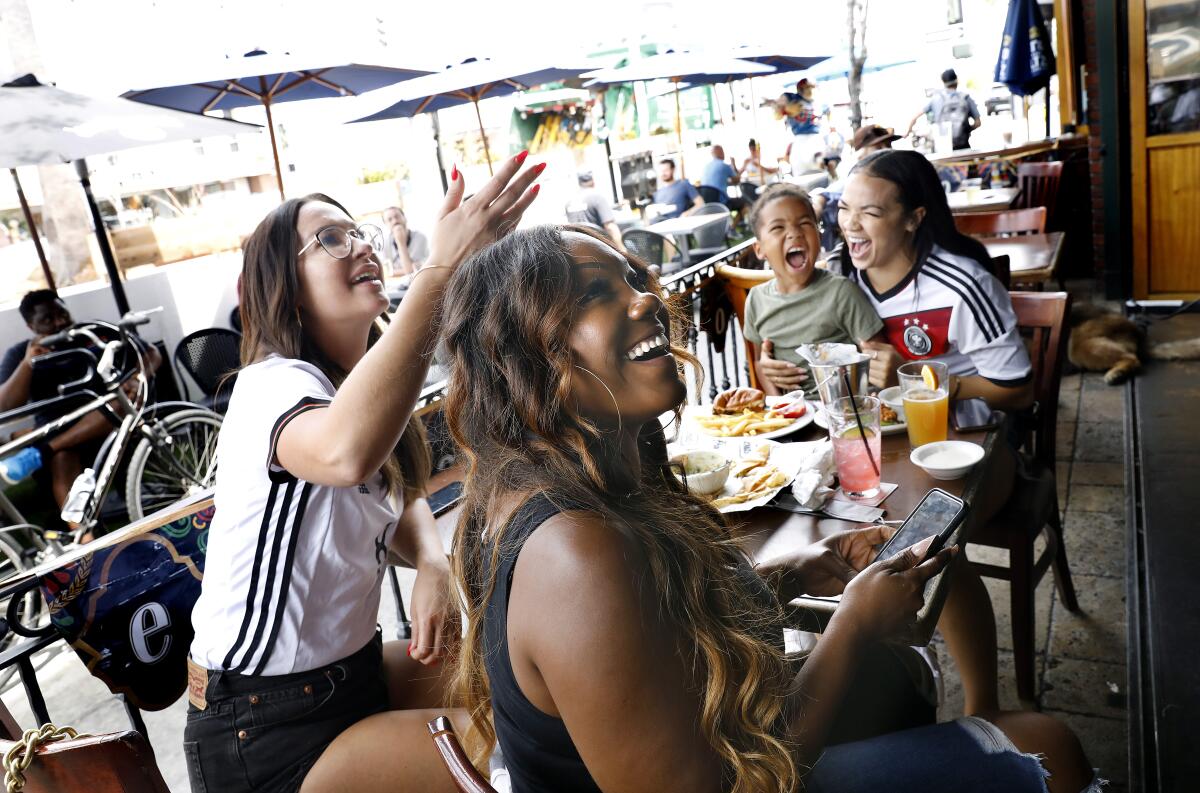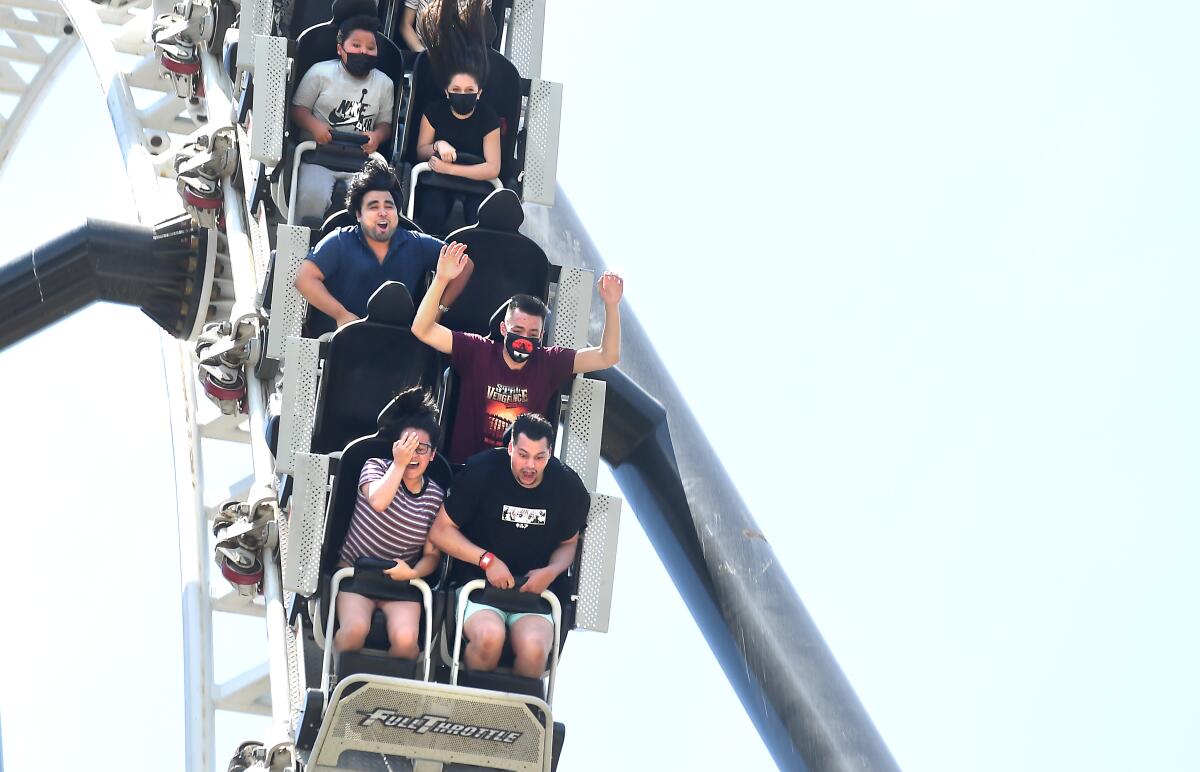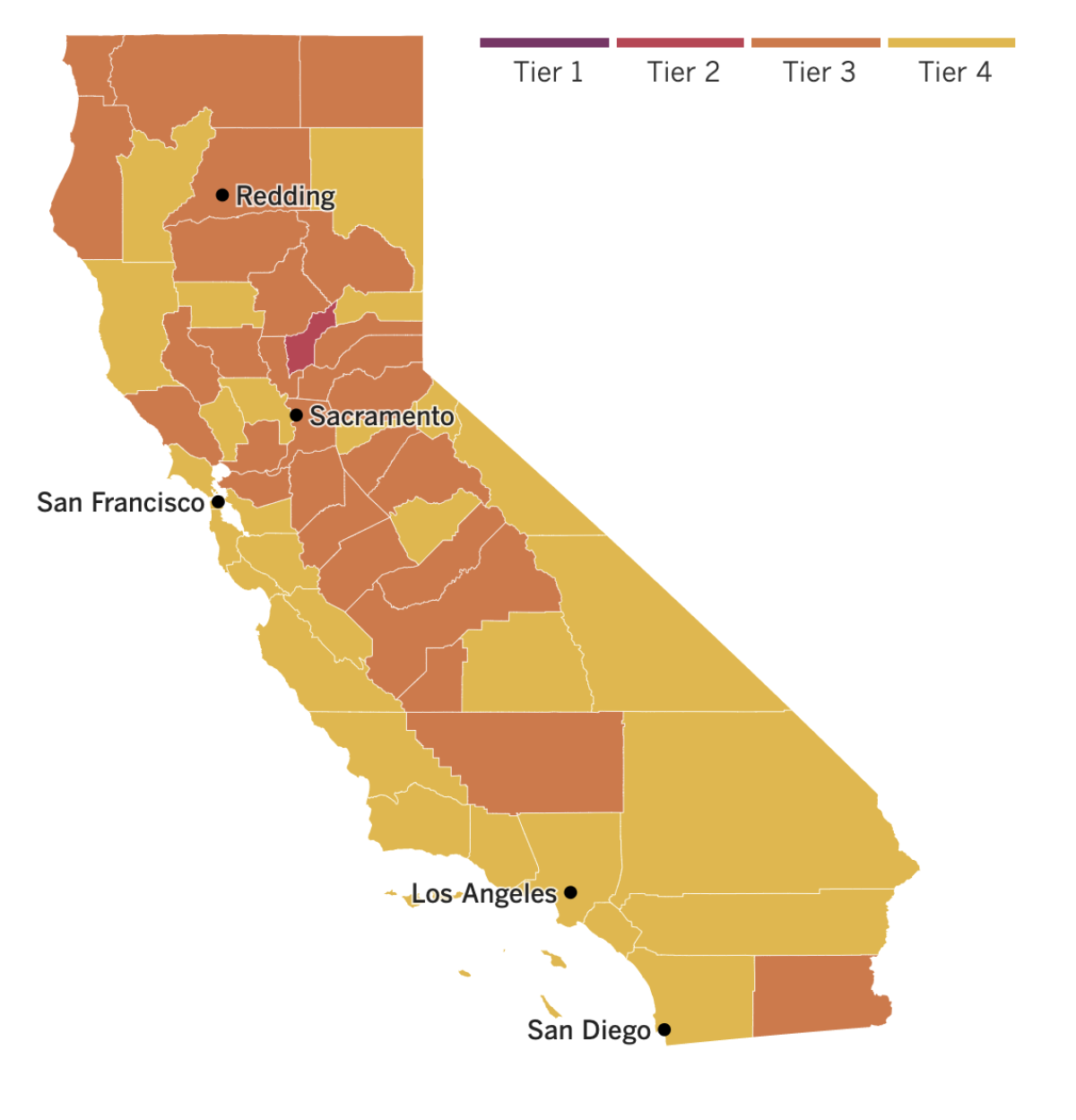Coronavirus Today: California is open! Now what?
Good evening. I’m Karen Kaplan, and it’s Tuesday, June 15. More importantly, it’s Reopening Day here in California! Here’s a look at what that means, plus the latest on the coronavirus elsewhere. And remember, we’ll be back in your inbox on Friday.
If you live in the Golden State, today is the day you’ve been waiting for since Gov. Gavin Newsom issued a stay-at-home order well over a year ago.
To an amazing degree, life can now return to something close to pre-pandemic normal. All kinds of businesses can reopen at full capacity, even indoors. People can stop standing six feet apart — and if they’re vaccinated, they can stop wearing masks (with a few exceptions — check today’s reader question for more detail).
But to enjoy these newfound freedoms, there’s one thing we need: trust.
We must trust in vaccines to keep us safe from the coronavirus that’s still out there.
We must trust others to protect themselves — and by extension us — by getting vaccinated or taking appropriate precautions.
We must trust health officials to make sound decisions based on science instead of politics.
“Trust will certainly affect how effectively we manage the recovery process,” Peter Kim, a professor of management and organization at USC, told my colleague Deborah Netburn.
Trust is broadly defined as a willingness to make oneself vulnerable in situations involving risk, said Kim, who is writing a book on the subject.
“Trust is probably the most important ingredient in a society,” he said. “It’s what allows us to engage in every sort of social, economic and cultural interaction we have in the world.”

Unfortunately, our trust in each other was waning even before the coronavirus arrived on U.S. shores. Then the pandemic made things worse.
The fear-based messaging and confusing statements from California’s public health leaders have made it difficult for residents to trust that they could ever return to living normally, said Dr. Monica Gandhi, an infectious-disease expert at UC San Francisco.
“We told people crazy things, like you can go to a mall that’s at 20% capacity and be around people you don’t know, but you can’t walk outside with another member of a different household,” Gandhi said. “That’s a major contradiction.”
Even when we have the best intentions, our brains can work against us. That’s because when we’re presented with facts and data, we’re hard-wired to digest them in ways that support our previously held beliefs.
“Information processing is something we do wrong very often,” said Isabelle Brocas, a USC economist who studies how we make decisions.
Getting people to trust one another again will be challenging, she said. The California economy may return to near-normal in a single day, but our sense of trust won’t.
“It is difficult to know how to pull out of it,” Brocas said. “It might just take time, and little by little, things change.”
By the numbers
California cases, deaths and vaccinations as of 7:29 p.m. Tuesday:

Track California’s coronavirus spread and vaccination efforts — including the latest numbers and how they break down — with our graphics.
Reopening roundup
Adam Cyril didn’t mean to ditch his mask before he walked into the Whole Foods in West Hollywood on Tuesday; he’d simply forgotten to bring it with him. But when he asked a clerk if the store could give him one, he was surprised by the response: He didn’t need one.
“It felt like I was restored as a human being again,” said Cyril, who described the experience as simultaneously novel and commonplace. “It actually felt like, ‘Boom. Am I in a time vortex? Did I just go back in time?’”
Those sentiments were surely felt throughout the state as Californians returned to fully opened restaurants, bars, gyms, movie theaters and — on the first day of a major heat wave — ice skating rinks.
“It’s one of the best days of my life,” said Langer’s Deli regular Najee Ali, who had gone at least 469 days without visiting the famed Los Angeles eatery. He celebrated by slathering a stack of pancakes with butter and syrup.
The list of California attractions that are back in business includes Disneyland, the San Diego Zoo, the Monterey Bay Aquarium, Alcatraz, the Ronald Reagan Presidential Library and Museum, the California Academy of Sciences and Universal Studios Hollywood. All of the state’s national parks — Channel Islands, Death Valley, Joshua Tree, Kings Canyon, Lassen Volcanic, Pinnacles, Sequoia and Yosemite — are open too.

(Check out this photo gallery for more great shots of joyous Californians enjoying their newfound freedom.)
Though it’s a landmark day, it’s not actually the first time the state has tried to reopen its economy during the pandemic. Hopefully, it’ll be the last.
When officials eased coronavirus restrictions last spring, and again in the fall, the resumption of activity triggered new surges of COVID-19. This reopening is on a much larger scale, but officials are optimistic that another surge can be avoided.
For starters, the state has averaged just 899 new coronavirus cases per day over the most recent seven-day period. That’s the lowest case counts have been since March 31, 2020, when the pandemic was just getting started. (In fact, coronavirus activity was probably higher then; we just lacked the tests needed to detect it.)
COVID-19 hospitalizations and fatalities are also far, far below their winter peaks. Over the last week, the state has averaged 15 COVID-19-related deaths per day — a dramatic decline from the high of 549.
Those figures are a testament to the power of COVID-19 vaccines. In California, 57% of all residents have received at least one dose of vaccine, and 48% of Californians are fully vaccinated. Millions also have some immunity from having been exposed to the coronavirus over the course of the pandemic.
But there’s more than numbers behind the optimism for this reopening — there’s real-world experience too. As counties have moved to less restrictive tiers under the now-retired Blueprint for a Safer Economy, rules have been eased without a corresponding increase in cases.
That’s not to say we’re completely out of the woods. In places with low vaccination rates, “we’re gonna see outbreaks,” said Dr. Mark Ghaly, the state’s Health and Human Services secretary.
He and other experts are particularly concerned about unvaccinated people spreading the Delta variant, a coronavirus strain first detected in India that is more transmissible than its predecessors and may be more resistant to COVID-19 vaccines and treatments.
With the economy reopened, there will be no more new tier assignments from the state each Tuesday. The last list was issued today, and the final tally is: 29 counties in the yellow tier, 28 in the orange and just one — Yuba — in the red.


Consider subscribing to the Los Angeles Times
Your support helps us deliver the news that matters most. Become a subscriber.
In other news
If you ever feel like COVID-19 has been around forever, a new study suggests you might be onto something.
Researchers from the National Institutes of Health and elsewhere analyzed blood samples drawn from 24,000 Americans in early 2020 to see if they contained antibodies that would indicate a past coronavirus infection. In nine cases, they found people who harbored the virus before the states where they lived had recorded any official COVID-19 cases.
One Illinois resident was infected as early as Christmas Eve, according to the study’s lead author. That’s a whole week before health officials in Wuhan, China, notified the world of a cluster of pneumonia cases that turned out to have been caused by a novel coronavirus.
The analysis, published Tuesday by the journal Clinical Infectious Diseases, is not definitive, and some experts remain skeptical. But its conclusions are in line with other research — including some by the U.S. Centers for Disease Control and Prevention — suggesting that the U.S. had a small number of coronavirus cases before the virus was on the world’s radar.
Nearly a year and a half later, COVID-19 has claimed more than 600,000 lives in the U.S. That milestone was topped Tuesday, according to the tracker maintained by Johns Hopkins University.
Experts believe many COVID-19 deaths have gone uncounted. But even at 600,000, the U.S. death toll — the highest in the world — is about equal to the number of Americans who died of cancer in 2019. It’s also greater than the population of Baltimore or Milwaukee.
The Johns Hopkins tracker counts more than 3.8 million deaths around the globe. That includes more than 490,000 deaths in Brazil and more than 377,000 in India.
It’s no secret that the coronavirus has proved adept at exploiting, and exposing, inequalities in the U.S. But an examination by the Associated Press shows how those disparities have shifted over the course of the pandemic.
During the first wave of fatalities, in April 2020, the virus rampaged through the urban Northeast and cities like Detroit and New Orleans. As a result, Black people died at rates higher than those of other ethnic or racial groups.
Latinos were hit the hardest during a second surge last summer. They suffered an outsize share of deaths, driven by infections in Texas and Florida.
By winter, during the third and most lethal stage, the virus had gripped the entire nation. Racial gaps in weekly death rates narrowed so much that white people were the worst off, followed closely by Latinos.
Now, even as the outbreak ebbs and more people get vaccinated, a racial gap appears to be emerging again, with Black Americans dying at higher rates than other groups.
Gaps in vaccination rates in the U.S. also persist, with Black people and Latinos lagging behind others. Those gaps could narrow, however, if getting vaccinated becomes a condition of employment.
San Francisco has stepped out on that limb, announcing Tuesday that it will eventually require workers in hospitals, nursing homes and jails to be fully vaccinated against COVID-19. Workers would be allowed to seek an exemption based on medical or religious grounds.
Many companies have avoided requiring workers to get vaccinated. But dozens of colleges nationwide, including campuses in the University of California and California State University systems, have said they will eventually require COVID-19 vaccinations for all students, faculty and staff on campus properties.
The order by San Francisco will go into effect only after the U.S. Food and Drug Administration gives full approval to one or more COVID-19 vaccines. Currently, all three vaccines being distributed in the U.S. have received emergency use authorization, which will expire when the nation’s public health emergency ends.
In other vaccine news, Novavax said this week that its shot was highly effective at preventing COVID-19 and also protected against coronavirus variants in a large, late-stage study in the U.S. and Mexico. The vaccine was about 90% effective overall, and preliminary data showed it was safe, the company said.
While demand for COVID-19 shots in the U.S. has dropped off dramatically, the need for more vaccines around the world remains critical. The Novavax vaccine, which is easy to store and transport, is expected to play an important role in boosting vaccine supplies in the developing world.
That help is still months away, however. The company says it plans to seek authorization for the shots in the U.S., Europe and elsewhere by the end of September and be able to produce up to 100 million doses a month by then.
“Many of our first doses will go to … low- and middle-income countries, and that was the goal to begin with,” said Novavax Chief Executive Stanley Erck.
And from the Department of Silver Linings: The pandemic prevented Girl Scouts across the country from setting up their traditional cookie-selling booths this year, leaving 15 million boxes of Girl Scout cookies unsold.
That’s bad news for the local councils and individual troops that count on cookie sales to fund their camping trips, badge workshops and other activities. But it could be good news for food banks and members of the military, who could wind up getting some of the excess cookie inventory for free.
The cookies have a one-year shelf life, but selling them outside of the window designated as Girl Scout Cookie Time might discourage sales in the future. The two companies that make the cookies — Little Brownie Bakers and ABC Bakers — have millions of boxes on their hands, and they’re working with the national Girl Scouts organization to donate them to worthy recipients.
Your questions answered
Today’s question comes from the many readers who want to know: Now that the economy has reopened, when do I need to wear a mask?
There are some places where everyone needs to wear a mask, regardless of your vaccination status. These include:
• Healthcare settings and long-term care facilities
• In airports or other transit hubs and aboard planes, buses and other public transportation
• Indoors at K-12 schools, child-care facilities or other youth settings
• In homeless shelters, emergency shelters and cooling centers
• In prisons, jails and detention centers
Unvaccinated people are still largely required to mask up when they’re in public indoor spaces, though there’s no uniform system for enforcing this.
Those who are fully vaccinated — that is, who are two weeks past their second dose of either the Pfizer-BioNTech or the Moderna vaccine or two weeks after their only dose of the Johnson & Johnson vaccine — are no longer required to wear masks in places like stores, restaurants, gyms, movie theaters or family entertainment centers. But they can keep their masks on if they feel more comfortable doing so.
“Nothing in the CDC guidelines says to stop wearing a mask,” Dr. José Mayorga, executive director of the UCI Health Family Health Centers, told Kaiser Health News. “It’s a recommendation, but if you choose to wear one, that’s OK. You shouldn’t be stigmatized.”
In some cases, wearing a mask is considered good etiquette even if you’re fully vaccinated. If you’re around children who are too young to be vaccinated, wearing a mask is a way to model good behavior. And if you’re in a business where workers are wearing masks, it can be respectful to wear one too.
Later this week, the state’s Occupational Safety and Health Standards Board is expected to vote on a proposal that would also allow fully vaccinated workers to remove their masks in the workplace and for physical distancing requirements to be rescinded.
Additional requirements remain in place for large indoor and outdoor venues and events — such as conventions, theme parks, concerts and sporting events.
Organizers of indoor events with more than 5,000 people will be required to verify that attendees either are fully vaccinated or have tested negative within 72 hours of the event’s start time. The same will be recommended, though not required, for organizers of outdoor events with more than 10,000 attendees. In those instances, venues will have the option of allowing unvaccinated and untested attendees, provided those people wear a mask at all times.
We want to hear from you. Email us your coronavirus questions, and we’ll do our best to answer them. Wondering if your question’s already been answered? Check out our archive here.
Resources
Need a vaccine? Sign up for email updates, and make an appointment where you live: City of Los Angeles | Los Angeles County | Kern County | Orange County | Riverside County | San Bernardino County | San Diego County | San Luis Obispo County | Santa Barbara County | Ventura County
Need more vaccine help? Talk to your healthcare provider. Call the state’s COVID-19 hotline at (833) 422-4255. And consult our county-by-county guides to getting vaccinated.
Practice social distancing using these tips, and wear a mask or two.
Watch for symptoms such as fever, cough, shortness of breath, chills, shaking with chills, muscle pain, headache, sore throat and loss of taste or smell. Here’s what to look for and when.
Need to get tested? Here’s where you can in L.A. County and around California.
Americans are hurting in many ways. We have advice for helping kids cope, resources for people experiencing domestic abuse and a newsletter to help you make ends meet.
We’ve answered hundreds of readers’ questions. Explore them in our archive here.
For our most up-to-date coverage, visit our homepage and our Health section, get our breaking news alerts, and follow us on Twitter and Instagram.




